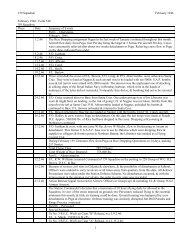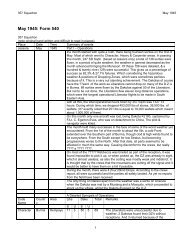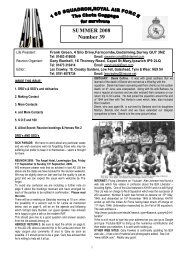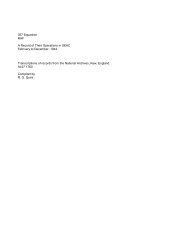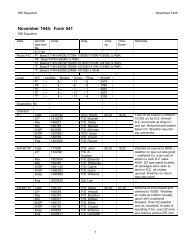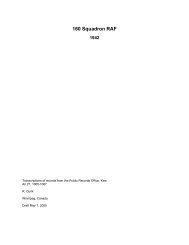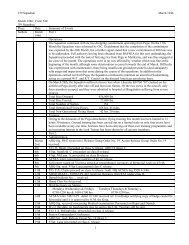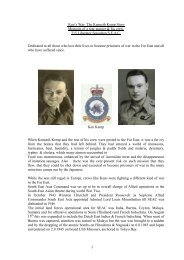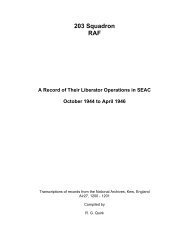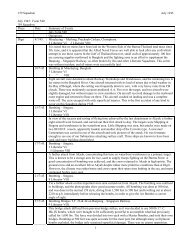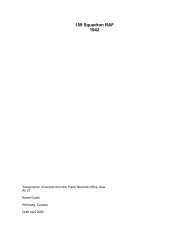RCAF Radar Personnel in WWII -North Atlantic Region-
RCAF Radar Personnel in WWII -North Atlantic Region-
RCAF Radar Personnel in WWII -North Atlantic Region-
You also want an ePaper? Increase the reach of your titles
YUMPU automatically turns print PDFs into web optimized ePapers that Google loves.
1RUWK $WODQWL 5HJLRQ<br />
the light-keepers houses which were to be their liv<strong>in</strong>g quarters were on another ledge some 400 feet<br />
higher! The houses hav<strong>in</strong>g been reached, Sgt. Moore could see, at the top of yet another steep rise,<br />
“.. .a Yagi array stick<strong>in</strong>g up from the top of a small hut surrounded by an earth bomb blast wall . .<br />
.” - his assigned radar station!<br />
The ASV gear found <strong>in</strong> the little hut presented an immediate problem - none of his radar mechanics<br />
had ever had even theoretical <strong>in</strong>struction on ‘airborne’ radar gear, and certa<strong>in</strong>ly no experience.<br />
However, resort to secret documents and considerable ‘trial and error’ eventually got the gear to top<br />
performance. Nolsoy radar rout<strong>in</strong>ely plotted local shipp<strong>in</strong>g and sometimes enemy aircraft - usually<br />
‘Weather Willies.’ One ‘shipp<strong>in</strong>g’ plot, however, rema<strong>in</strong>ed unidentified for some time. A ‘visual’<br />
by Nolsoy’s personnel confirmed that the target was <strong>in</strong> fact a U-boat; quick reaction by a Norwegian<br />
gun-boat and a British corvette resulted <strong>in</strong> the German sub be<strong>in</strong>g “ . . . blown out of the<br />
water . . ..” It was ‘thumbs - up’ for the Nolsoy radar crew!<br />
Actually, the major enemy at Nolsoy (and at the other radar units <strong>in</strong> the Faroes) was WIND, which<br />
frequently made it necessary to ‘lash’ the Yagi array for protracted periods, with consequent serious<br />
loss of radar coverage. However, dur<strong>in</strong>g set-up trials on some new gear, plots on aircraft were<br />
observed despite the fact that the antennae was <strong>in</strong>side a wooden build<strong>in</strong>g. Sgt. Moore proposed that<br />
a comprehensive trial be done near the RAF’s fly<strong>in</strong>g-boat base at nearby Vagar lake; sheets of<br />
plexiglass known to be held <strong>in</strong> Vagar Stores would be mounted on wooden frames to form a rigid<br />
‘w<strong>in</strong>d-shield’ around the Yagi aerial array. Authorities approved, and an entry <strong>in</strong> Moore’s diary,<br />
dated 18 Aug. 1943, reads “ . . .w<strong>in</strong>dscreen up, and gear go<strong>in</strong>g as good as ever . . .” Formal trials,<br />
us<strong>in</strong>g aircraft of known size as targets, <strong>in</strong>dicated ‘normal performance.’ The plexiglass ‘w<strong>in</strong>dshield’<br />
appeared not to be <strong>in</strong>terfer<strong>in</strong>g with the radar beam, and it did enable normal antenna rotation despite<br />
high w<strong>in</strong>ds. Eureka!: Nolsoy had <strong>in</strong>vented the Radome! (the event was later dubbed, somewhat<br />
unk<strong>in</strong>dly, ‘Faroe Madness’!). Sgt. Moore was then directed to do similar ‘radome’ <strong>in</strong>stallations at<br />
other sites before return<strong>in</strong>g to the UK and Canada.<br />
Hal Cairns memoirs conta<strong>in</strong> references to two other <strong>RCAF</strong> radar men who served <strong>in</strong> the Faroes:<br />
Craig Knudsen of Toronto, who served on the Naval radar at Eide, and Peter Moon (his Faroe site<br />
and home town not recorded).<br />
Shetlands :<br />
The vulnerability of Scapa Flow, particularly after German forces ga<strong>in</strong>ed control of the entire<br />
western coast of Norway, caused the Royal Navy to extend the coverage provided by the two<br />
Orkney radar stations (previously mentioned) by putt<strong>in</strong>g one radar unit on Fair Isle midway between<br />
Orkneys and Shetlands and two on the Shetlands, us<strong>in</strong>g three CHL radars borrowed from the RAF.<br />
A shortage of Naval radar technicians, or lack of experience on CHL gear, (it is not clear which<br />
applied) led to the Navy ask<strong>in</strong>g for RAF radar mechanics; this request resulted <strong>in</strong> several <strong>RCAF</strong><br />
radar men do<strong>in</strong>g service on the three Naval stations mentioned above.<br />
,9




